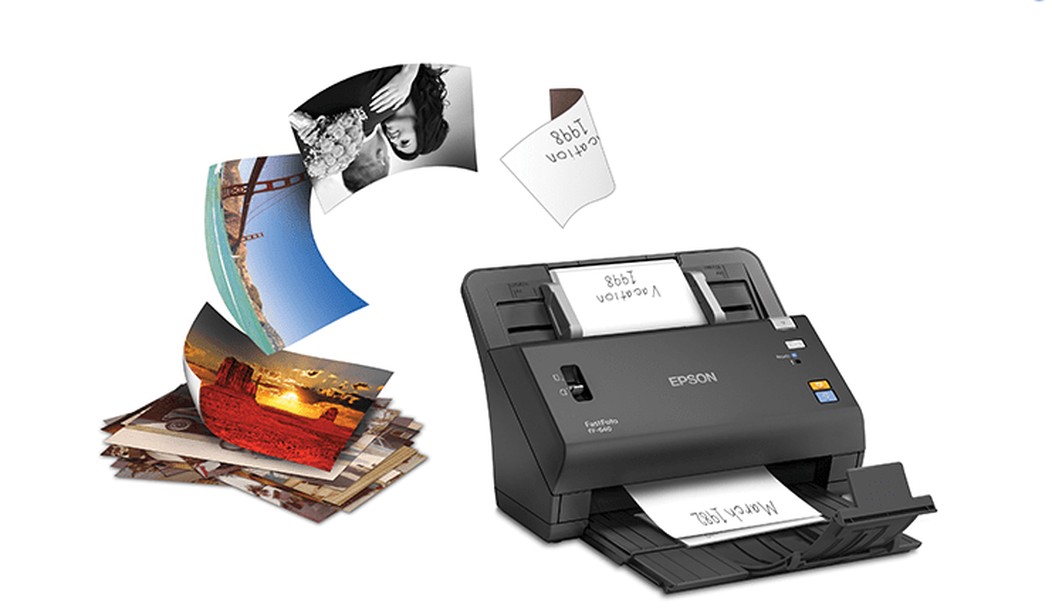Many of us have collections of old photos sitting in shoeboxes, drawers and albums. Epson has just released a new scanner designed to help us preserve them for future generations.
Digital scanners are one of the least glamorous of our computer peripherals and are often an afterthought, acquired as part of an all-in-one device that includes a printer, fax and scan capabilities. And scanning is often complicated, requiring careful positioning of the document and the use of obtuse software with a myriad of confusing settings.
In spite of this, scanners can can provide great utility, digitizing important documents, receipts, and photos, eliminating paper clutter and storing important contracts. It’s also useful for digitizing a sketch to add to a document or to email to others.
There are two types of scanners: flatbed and sheet. On the flatbed, the style usually found on the all-in-one printers, a scan head travels the length of the fixed document to capture the image, much like a copy machine. It works best for scanning books, photos, and documents one at a time.
The second type of scanner is the dedicated stand-alone device that feeds the originals through a slot over a fixed scanner head. This type of scanner has become particularly useful, because they are fast, easy to use, take up less room, and come with software that’s often more versatile and easier to use.
I’ve been using a Fujitsu ScanSnap iX500 ($420) over the past several years, and find I use it several times a week for various needs, such as signing a document and then digitizing and emailing it, storing receipts and sending sketches. The scanner starts up in seconds, allows me to quickly drop in the document to be scanned, and turns it into a digital PDF file for storing and sharing. It can also do photos, creating an image very much like the original, but often a little more contrasty.
But I’ve recently been trying out a new scanner that looks much like the Fujitsu, but is designed especially to scan photos of all types. It’s the Epson FastFoto FF-640 scanner that claims to be the world’s fastest photo scanner, scanning a photo in as little as a second. While this sheet feed scanner can scan both documents and photos, it excels as a photo scanner, and scans both sides at once to capture any notes or information on the reverse.
Built-in software analyzes the photos and corrects them for fading, color, and the degradation that occurs to photos over the years. Photos are chemically based and all will degrade over time, more rapidly when they are exposed to heat and light.
The Epson FastFoto FF-640 is not inexpensive at $649.99, but after using it for a week, I’ve discovered it can dramatically improve old photos. That’s the result of the powerful Epson software.
My wife has created several dozen photo albums over the years of our family, even though we now use digital cameras and store images on iPhoto and Google Photo. She prefers to leaf through an album of memories looking at real photos, including those that were passed down from our family that are as much as 100 years old. In turn, it’s a collection we will pass down to our children.
But our old photos, pre-digital in particular, have changed color, lost contrast, and faded. To prevent further loss, the best way to preserve them is to scan them into jpeg images and save them using one of the cloud services. Or you can use professional restoration services that charge from $10 to $30 to create a digital image and manually correct it.
The Epson printer is designed to automate this entire process, to make it as painless as possible to do, and to provide an alternative to using outside custom services. It’s designed to allow you to take an album or a shoebox full of photos and restore them faster than any other way.
FastFoto scans photos to your computer or any other designated location. One of the challenges in scanning a collection of old photos is that they vary in size and shape. With the FotoFast, I was able to stack together 5- 10 photos at a time, place them into the scanner feed tray, and they would feed through the scanner automatically in just a few seconds, using the scanner’s built-in auto size correction. The scanner software automatically adjusted the angle at which the photos went through the scanner and made corrections using software if one was still skewed. Double feeds are also detected, although that never occurred in my testing.
Before I placed a stack of my valuable photos in the feed tray I tried feeding less valuable ones through one at a time, then a couple more, to insure the scanner would not destroy a priceless photo. The scanner also comes with a clear plastic carrier to scan photos that are torn or physically damaged.
I scanned in about 300 pictures, one album’s worth, in about 2 hours. The images included color, black and white, both recent and very old. The results were as impressive as anything I’ve tried doing by hand. The images were generally significantly better than the original, except for recent images that required no improvement, and those appeared identical to the original. Images were scanned into a file that allowed me to retitle and move them one at a time to other locations.
While positioned as the best solution for photos, the scanner handled documents equally well, comparable to the Fujitsu. I scanned in a bunch of receipts, printed documents, and forms that I had printed out and signed.
The software allowed me to choose whether I wanted the scanned images to be in jpeg format (for photos) or PDF format for documents. With all of the automation provided, it would have been more convenient if the scanner could make that choice automatically based on the document type. I could choose 300dpi or 600 dpi, but found 300dpi to be sufficient.
We are now beginning the task of digitizing about a dozen large photo albums, one by one. We would never have taken on this task before. But the Epson FastFoto FF-640 makes it all possible with less effort than would be otherwise be possible.








Join the conversation as a VIP Member